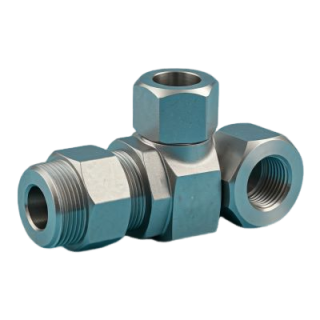Hydraulic systems are the lifeblood of countless industries, powering everything from heavy machinery to delicate medical equipment. At the heart of these systems lie hydraulic bulkhead fittings, often overlooked but critical components that ensure the integrity and efficiency of fluid flow.
In this blog post, we’ll delve into the world of hydraulic bulkhead fittings, exploring their types, selection criteria, installation best practices, and maintenance tips.
Understanding Hydraulic Bulkhead Fittings
What are hydraulic bulkhead fittings?
Hydraulic bulkhead fittings are specialized connectors designed to penetrate bulkheads or walls in hydraulic systems. They provide a secure and leak-proof connection between components on either side of the barrier.
Key roles of bulkhead fittings in hydraulic systems:
➡️ Isolation: Separating high-pressure hydraulic fluid from other system components or compartments.
➡️ Seal integrity: Preventing leaks and maintaining system pressure.
➡️ Durability: Withstanding harsh environments and vibration.
➡️ Flexibility: Accommodating various system configurations and fluid types.
Types of Hydraulic Bulkhead Fittings
Overview of common bulkhead fitting designs:
➡️ Straight bulkhead fittings: Simple design for direct penetration.
➡️ Elbow bulkhead fittings: Angled for optimal component placement.
➡️ Tee bulkhead fittings: Create branching connections within the system.
Material options and their applications:
➡️ Stainless steel: Excellent corrosion resistance and high strength for demanding applications.
➡️ Brass: Good balance of strength and corrosion resistance for general-purpose use.
➡️ Carbon steel: Cost-effective for low-pressure systems.
➡️ Other materials: Consider specialized materials like nickel-plated brass or Teflon for specific applications.
Critical Factors to Consider When Choosing Bulkhead Fittings
Assessing system pressure and compatibility:
➡️ Pressure rating: Ensure the fitting’s pressure rating exceeds the maximum system pressure.
➡️ Fluid compatibility: Choose materials that are resistant to the specific fluid used in the system.
Evaluating environmental conditions and durability needs:
➡️ Temperature range: Select fittings that can withstand extreme temperatures.
➡️ Vibration resistance: Consider vibration dampening features for harsh environments.
➡️ Corrosion resistance: Choose materials that are resistant to corrosive substances.
Thread Standards and Compatibility
Understanding thread types: UNF, BSP, and metric threads:
➡️ UNF (Unified National Fine): Common in North American applications.
➡️ BSP (British Standard Pipe): Widely used in European and global systems.
➡️ Metric threads: Standardized metric threads for specific applications.
Ensuring compatibility with existing hydraulic systems:
➡️ Thread size and pitch: Verify compatibility with existing components.
➡️ Seal compatibility: Ensure proper sealing between the fitting and the bulkhead.
Sizing Guide for Hydraulic Bulkhead Fittings
Determining the correct size for optimal flow and system efficiency:
➡️ Flow rate: Calculate the required flow rate to select the appropriate size.
➡️ Pressure drop: Minimize pressure loss by choosing the correct size.
Avoiding common sizing mistakes:
➡️ Undersizing: Can lead to excessive pressure drop and reduced performance.
➡️ Oversizing: May cause unnecessary bulk and increased cost.
Material Selection Tips for Bulkhead Fittings
Comparing stainless steel, brass, and other materials:
➡️ Stainless steel: Superior corrosion resistance and strength, but higher cost.
➡️ Brass: Good balance of properties and cost-effective.
➡️ Carbon steel: Lower cost but requires protective coatings in corrosive environments.
How material impacts performance and longevity:
➡️ Corrosion resistance: Prevents degradation and extends lifespan.
➡️ Strength: Ensures durability under pressure and vibration.
➡️ Weight: Impacts system weight and installation ease.
Installation Best Practices
Step-by-step guide to secure installation:
1. Prepare the bulkhead: Clean and deburr the hole to ensure a smooth fit.
2. Apply sealant: Use a suitable sealant to prevent leaks.
3. Insert the fitting: Thread the fitting into the bulkhead, ensuring proper alignment.
4. Tighten securely: Use a torque wrench to achieve the recommended torque.
Troubleshooting common installation issues:
➡️ Leaks: Check for damaged threads, improper sealant application, or overtightening.
➡️ Difficulty threading: Use thread lubricant to facilitate installation.
Maintaining and Inspecting Hydraulic Bulkhead Fittings
Tips for regular maintenance and inspections:
➡️ Visual inspection: Check for signs of damage, corrosion, or leaks.
➡️ Tightness checks: Verify that fittings are securely tightened.
➡️ Fluid cleanliness: Ensure clean fluid to prevent premature wear.
Recognizing signs of wear and when to replace fittings:
➡️ Corrosion: Visible signs of rust or pitting.
➡️ Cracks or damage: Physical damage to the fitting.
➡️ Leaks: Fluid leakage around the fitting.
➡️ Excessive vibration: Loose or damaged fittings.
Top Industry Recommendations for Reliable Bulkhead Fittings
Features to look for in high-quality fittings:
➡️ High-quality materials: Stainless steel or brass for durability.
➡️ Precision manufacturing: Ensures accurate fit and performance.
➡️ Reliable seals: Prevent leaks and maintain system integrity.
➡️ Vibration resistance: Designed to withstand harsh environments.
Conclusion
By following these expert tips and considering the critical factors discussed, you can select the most suitable hydraulic bulkhead fittings for your specific application. Remember, proper installation, maintenance, and regular inspections are essential to ensure long-term system performance and reliability.
Post time: Nov-20-2024


